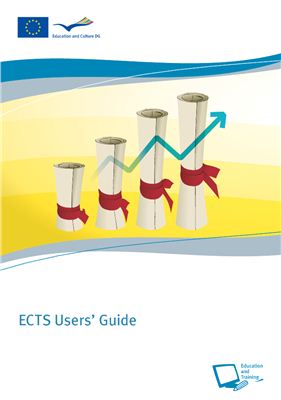Luxembourg: Office for Official Publications of the European
Communities, 2009, 64 p.
This ECTS Users’ Guide provides guidelines for implementation of the European Credit Transfer and Accumulation System (ECTS). It also presents the ECTS key documents. The Guide is offered to assist leaers, academic and administrative staff in higher education institutions as well as other interested parties.
The 2009 Users’ Guide elaborates on the previous version of 2005. It has been updated to take account of developments in the Bologna Process, the growing importance of lifelong leaing, the formulation of qualifi-cations frameworks and the increasing use of leaing outcomes. It has been written with the help of experts from stakeholders’ associations and ECTS counsellors, and submitted for consultation to stakeholders’ as-sociations, Member States’ experts and the Bologna Follow-up Group. The European Commission has coordi-nated the drafting and consultation process and is responsible for the final wording of the Guide.
This ECTS Users’ Guide provides guidelines for implementation of the European Credit Transfer and Accumulation System (ECTS). It also presents the ECTS key documents. The Guide is offered to assist leaers, academic and administrative staff in higher education institutions as well as other interested parties.
The 2009 Users’ Guide elaborates on the previous version of 2005. It has been updated to take account of developments in the Bologna Process, the growing importance of lifelong leaing, the formulation of qualifi-cations frameworks and the increasing use of leaing outcomes. It has been written with the help of experts from stakeholders’ associations and ECTS counsellors, and submitted for consultation to stakeholders’ as-sociations, Member States’ experts and the Bologna Follow-up Group. The European Commission has coordi-nated the drafting and consultation process and is responsible for the final wording of the Guide.

